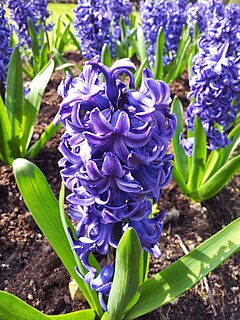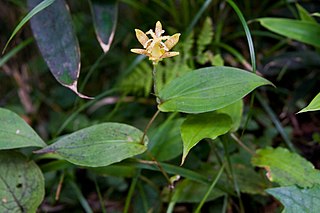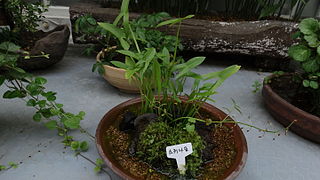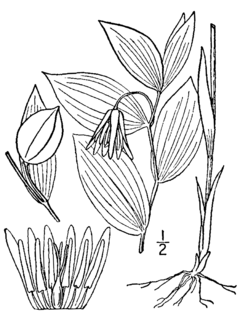
Royal Botanic Gardens, Kew, is a non-departmental public body in the United Kingdom sponsored by the Department for Environment, Food and Rural Affairs. An internationally important botanical research and education institution, it employs 1,100 staff. Its board of trustees is chaired by Dame Amelia Fawcett.

Oryza is a genus of plants in the grass family. It includes the major food crop rice. Members of the genus grow as tall, wetland grasses, growing to 1–2 m tall; the genus includes both annual and perennial species.

Hyacinthus is a small genus of bulbous, spring-blooming perennials. They are fragrant flowering plants in the family Asparagaceae, subfamily Scilloideae and are commonly called hyacinths. The genus is native to the area of the eastern Mediterranean from the north of Bulgaria through to the northern part of the region of Palestine.

Muscari is a genus of perennial bulbous plants native to Eurasia that produce spikes of dense, most commonly blue, urn-shaped flowers resembling bunches of grapes in the spring. The common name for the genus is grape hyacinth, but they should not be confused with hyacinths. A number of species of Muscari are used as ornamental garden plants.

Daphniphyllum is the sole genus in the flowering plant family Daphniphyllaceae and was described as a genus in 1826. The genus includes evergreen shrubs and trees mainly native to east and southeast Asia, but also found in the Indian Subcontinent and New Guinea.

Ephedra sinica is a species of Ephedra native to Mongolia, Russia, and northeastern China.

Alisma gramineum is a small aquatic plant in the water-plantain family. It has several common names including narrowleaf water-plantain, ribbonleaf water-plantain or ribbon-leaved water-plantain, and grass-leaved water-plantain. It grows in mud or submerged in shallow fresh or brackish water in marshy areas.

Fimbristylis is a genus of sedges. A plant in this genus may be known commonly as a fimbry or fimbristyle. There are 200 to 300 species distributed worldwide. Several continents have native species but many species have been introduced to regions where they are not native. Some are considered weeds. These are typical sedges in appearance, with stiff, ridged stems and cone-shaped terminal panicles of spikelets. They are found in wet environments, and are most diverse in tropical and subtropical regions.

Holarrhena pubescens is a species of flowering plant in the family Apocynaceae. It is native to central and southern Africa, the Indian Subcontinent, Indochina, and parts of China. In Cambodia, it is called /tɨk dɑh kʰlaː thɔm/ ទឹកដោះខ្លាធំ big tiger milk or /kʰlaɛɲ kŭəŋ/ ខ្លែងគង់ invulnerable kite. These seeds are sold as indraja (इनद्राजा) for Ayurvedic medicine in India.

Tricyrtis latifolia, the toad lily, is an East Asian species of plants in the lily family.

Amana is a small genus of flowering bulbs in the lily family, closely related to tulips and included in Tulipa by some authors. Amana is found in China, Japan and Korea. As of June 2012 the World Checklist of Selected Plant Families recognizes four species, three of which were formerly placed in the genus Tulipa:
The World Checklist of Selected Plant Families is an "international collaborative programme that provides the latest peer reviewed and published opinions on the accepted scientific names and synonyms of selected plant families." Maintained by the Royal Botanic Gardens, Kew, it is available online, allowing searches for the names of families, genera and species, as well as the ability to create checklists.
Najas wrightiana is a species of aquatic plant in the Hydrocharitaceae family. It is referred to by the common name Wright's waternymph, and is found in lakes and streams. It is native to Mexico, Guatemala, Belize, Honduras, the Bahamas, Cuba, and Venezuela. It is also considered introduced and naturalized in southern Florida.

Najas gracillima, the slender waternymph, is a submerged species of aquatic plant in the Hydrocharitaceae family. found in lakes and streams. It is native to China, Russian Far East, Japan, Korea, Taiwan, Iran, Alberta, Ontario, Newfoundland, Nova Scotia, New Brunswick, the eastern United States. It is also considered introduced and naturalized in France, Spain, Italy and California.

Sagittaria trifolia, the threeleaf arrowhead or Chinese arrowhead, is a plant species widespread across the wet areas in Europe and in much of Asia.

Uvularia puberula, the mountain bellwort, is a plant species native to the eastern United States. It is common across Virginia, North and South Carolina, West Virginia, and adjacent parts of northern Georgia, eastern Tennessee, eastern Kentucky and southern Pennsylvania. Isolated populations have been found in southern Georgia, northern Alabama, southern New Jersey, and Long Island in New York State.

Hydrocleys nymphoides, the waterpoppy or water-poppy, is an aquatic plant species in the Alismataceae. It is widespread across South America, Central America, Puerto Rico, Trinidad and the Netherlands Antilles. It is cultivated in many places for used in decorative ponds and artificial aquatic habitats, and naturalized in Australia, New Zealand, South Africa, Fiji, New Caledonia, French Polynesia, Florida, Louisiana and Texas.

Tulipa sylvestris, the wild tulip or woodland tulip, is a Eurasian and North African species of wild tulip, a plant in the lily family. Its native range extends from Portugal and Morocco to western China, covering most of the Mediterranean and Black Sea Basins, and Central Asia. The species is also cultivated as an ornamental and naturalized in central and northern Europe as well as a few scattered locations in North America. It was first recorded as being naturalised in Britain in the late 17th century.
Bambusa australis is a species of Bambusa bamboo.















